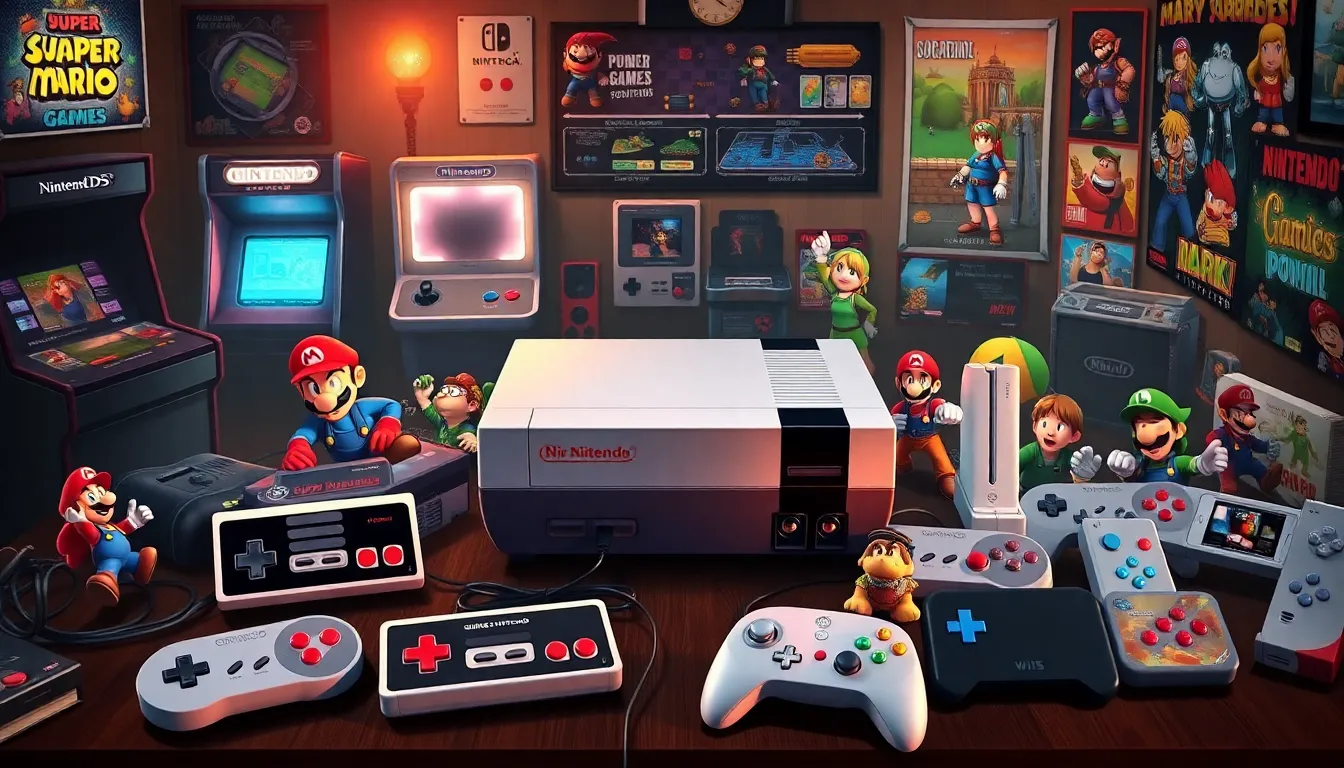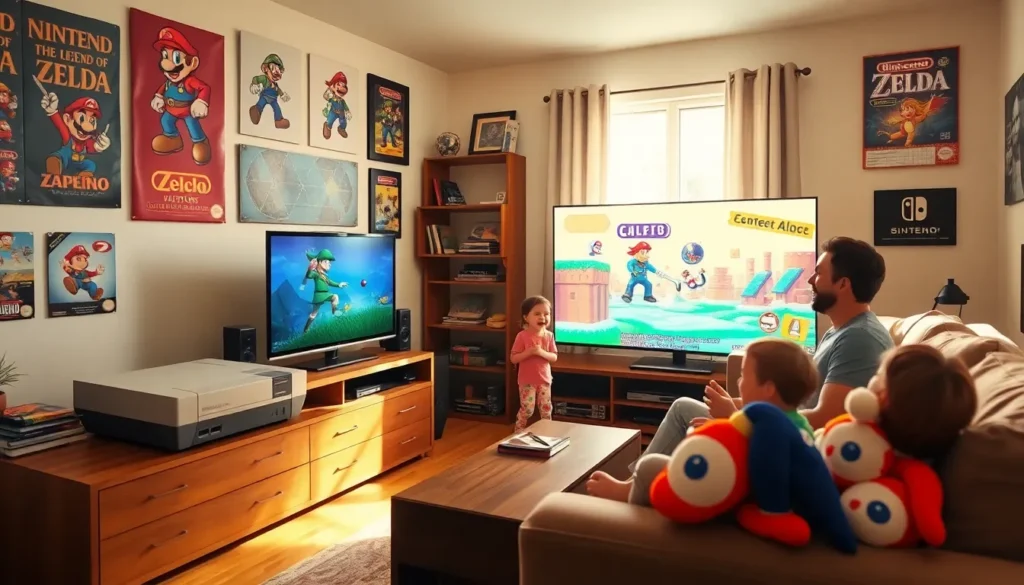Table of Contents
ToggleNintendo has been a cornerstone of the gaming world for decades, captivating audiences of all ages with its innovative titles and iconic characters. From the early days of the 1980s to the current era of groundbreaking technology, Nintendo’s journey is rich with creativity and influence. This article delves into the evolution of Nintendo, exploring its history, popular franchises, unique titles that have defined generations, and what the future may hold for this legendary company.
The Evolution of Nintendo: A Brief History

Nintendo, originally founded as a playing card company in 1889, has undergone a remarkable transformation over the years to become a giant in the gaming industry. It began experimenting with arcade games in the 1970s, and its foray into home gaming began in earnest with the release of the Nintendo Entertainment System (NES) in 1985.
Key Milestones in Nintendo’s Journey
The NES revival revolutionized the gaming landscape, proving critical in rejuvenating an industry that had nearly collapsed. Over subsequent years, Nintendo introduced a series of consoles, the Super Nintendo Entertainment System (SNES), the Nintendo 64, and the GameCube, that not only pushed the envelope for home entertainment but also cultivated an expansive library of beloved games.
In 2004, the company shifted gears with the release of the Nintendo DS, introducing dual screens and touch controls, setting standards for handheld gaming. The Wii, launched in 2006, further diversified gaming with motion controls, bringing a broader audience into the fold, including non-traditional gamers. Today, consoles like the Nintendo Switch continue to innovate, blending handheld and home console gaming, showcasing Nintendo’s commitment to evolving alongside technology and consumer preferences.
Impact of Nintendo on the Gaming Industry
Nintendo’s influence on the gaming industry is immeasurable. Its approach to game design emphasized accessibility, engaging narratives, and unforgettable characters. Iconic franchises such as Mario and Zelda not only redefined genres but also established benchmarks for game development, inspiring countless creators and companies worldwide. Nintendo’s dedication to fostering creativity has shaped the gaming landscape, driving both technological advancements and storytelling approaches that define modern gaming today.
Popular Nintendo Franchises Through the Years
Nintendo boasts an impressive catalog of franchises that have continued to resonate with players over generations. These franchises have not only become synonymous with Nintendo but also serve as cultural touchstones for millions.
The Legend of Zelda: A Timeless Adventure
First introduced in 1986, “The Legend of Zelda” has evolved into an epic saga that blends action, adventure, and puzzle-solving in a richly imagined world. Each installment builds upon the last, weaving narratives and gameplay mechanics that challenge players in innovative ways. With standout titles like “Ocarina of Time” and “Breath of the Wild,” the franchise has won countless awards and set industry standards for world-building and exploration.
Super Mario: The Face of Nintendo
Since the dawn of the gaming age, Mario has served as Nintendo’s flagship character. From his first appearance in “Donkey Kong” to starring in titles like “Super Mario Odyssey,” Mario’s adventures have become a benchmark for platformer games. The franchise’s blend of creative level design, engaging mechanics, and catchy music has secured Mario a place in the hearts of gamers, offering experiences that are both challenging and enjoyable.
Unique Titles That Defined Generations
Beyond its flagship franchises, Nintendo has produced a variety of unique titles that have left lasting impacts on gaming.
Cult Classics and Hidden Gems
Games like “EarthBound,” “Metroid Prime,” and “Kid Icarus” have garnered dedicated fanbases even though varying degrees of commercial success. These titles are often praised for their innovative gameplay, unique art styles, and engaging narratives. They challenge players in ways that often diverge from mainstream gaming, fostering a culture of appreciation among those who seek out these hidden gems.
Innovative Gameplay Mechanics
Nintendo has a legacy of introducing groundbreaking gameplay mechanics. Titles like “Wii Sports” brought families together through simple yet engaging gameplay, while “Splatoon” redefined team-based multiplayer gaming with a fresh approach to competition. Such innovations show how Nintendo continuously seeks to enhance player experience and set trends within the industry.
The Future of Nintendo: What Lies Ahead?
As technology continues to advance, Nintendo remains at the forefront of innovation.
Anticipated Releases and Trends
Upcoming releases, such as the next installment of the “Zelda” or a new “Metroid” game, excite long-time fans and younger audiences alike. With the Nintendo Switch leading in sales, future enhancements in gameplay and graphics are eagerly awaited. Many fans speculate on the potential of virtual reality in forthcoming Nintendo titles, fostering a new wave of immersive experiences.
Nintendo’s Role in Next-Gen Gaming
Nintendo’s approach to next-gen gaming often diverges from the paths taken by its competitors. While others may focus on sheer graphical power, Nintendo emphasizes creativity and gameplay innovation. This approach not only enriches the gaming community but also solidifies Nintendo’s position as a beloved and respected leader in the industry.
Conclusion
Nintendo’s incredible journey reflects a company that embraces change while holding fast to the core principles of creativity and fun. Its history is marked by memorable characters, influential franchises, and innovative gameplay that have collectively shaped the gaming world. As it looks toward the future, Nintendo continues to inspire both players and developers, ensuring that gaming remains an exciting and dynamic form of entertainment.





